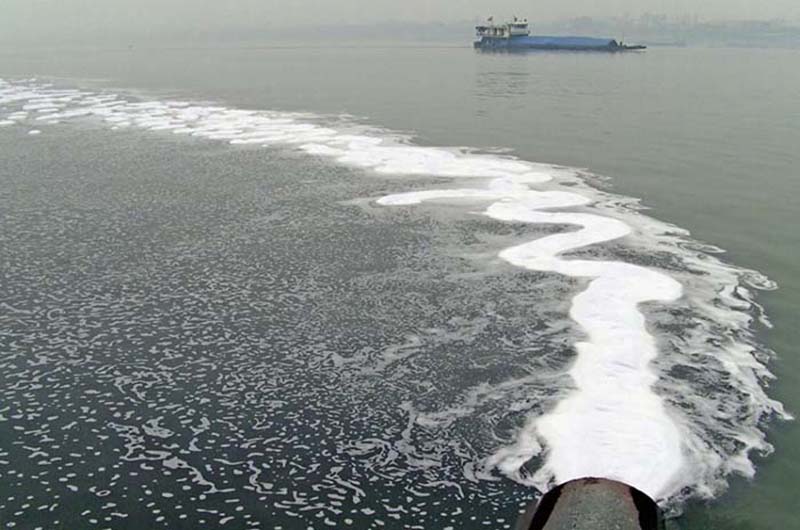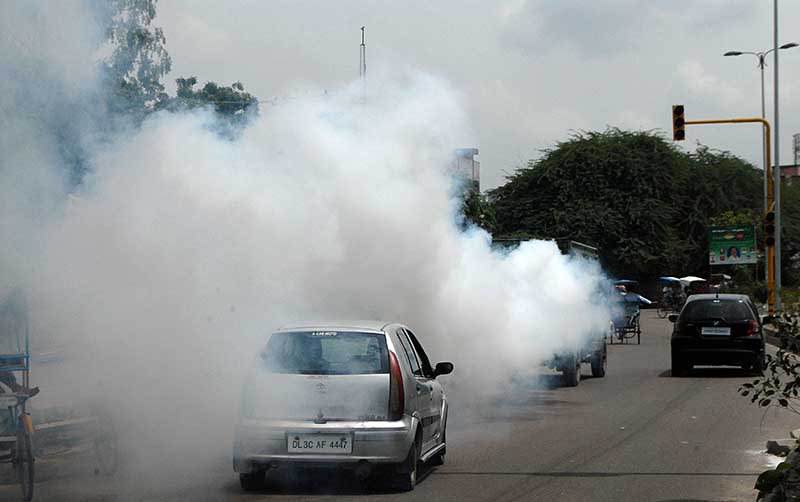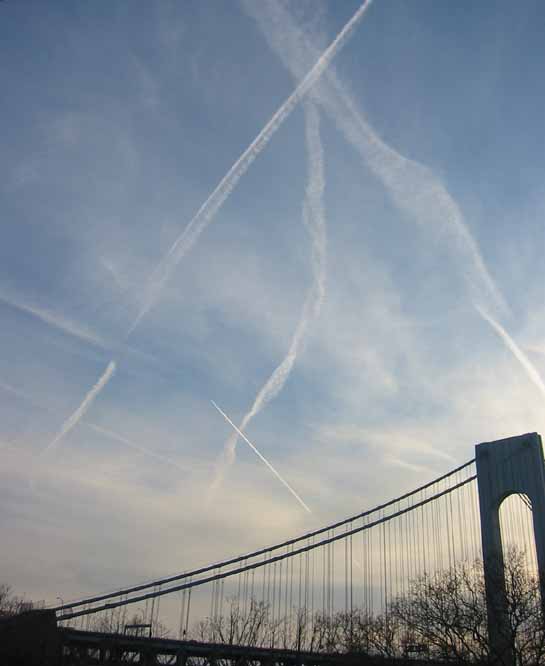



Pollution is the introduction of contaminants into the natural environment that cause adverse change. Pollution can take the form of chemical substances or energy, such as noise, heat or light. Pollutants, the components of pollution, can be either foreign substances/energies or naturally occurring contaminants. Pollution is often classed as point source or nonpoint source pollution. In 2015, pollution killed 9 million people in the world. Major forms of pollution include: Air pollution, light pollution, littering, noise pollution, plastic pollution, soil contamination, radioactive contamination, thermal pollution, visual pollution, water pollution. Read more
In the spring of 2020 global pollution levels dropped when people stayed home because of the COVID-19 Pandemic.
Light Pollution: The Night Sky Is Twice as Bright as It Was Only 8 Years Ago Science Alert - January 19, 2023 
As city folk sleep blanketed by the warm glow of artificial light that surrounds urban centers, stargazers feel the chill of the night sky and see all its constellations being smudged into a fuzzy blur by those same urban lights. A new study shows that the night sky is getting brighter at a staggering rate worldwide and much faster than satellites had previously indicated. In other words, the dimmest stars in the night sky are fast disappearing as artificial light illuminates the night sky.
Invisible Air Pollution in The Country May Be Just as Toxic as The Smog of The City Science Alert - February 1, 2022
It's easy to see air pollution when it settles as smog over a city. Yet even in rural areas, where the air looks clearer, researchers have found unhealthy particles floating in the atmosphere.
Estimating deaths globally from air pollution PhysOrg - January 7, 2022
Two studies highlighting the scale of potentially life-threatening air pollution in urban areas have been published. According to the modeling studies by US-based research teams, approximately 86% of people living in urban areas across the globe, or 2.5 billion people, are exposed to unhealthy particulate matter levels, leading to an estimated 1.8 million excess deaths in cities globally in 2019. Additionally, nearly 2 million asthma cases among children worldwide were attributable to NO2 (nitrogen dioxide gas) pollution in 2019, with two in three occurring in urban areas.
Scientists just sampled the most pristine air on Earth. Here's what they found. Live Science - June 21, 2020
The Southern Ocean is a vast band of open water that encircles the entire planet between Antarctica and the Southern Hemisphere landmasses. It is the cloudiest place on Earth, and the amount of sunlight that reflects off or passes through those clouds plays a surprisingly important role in global climate. It affects weather patterns, ocean currents, Antarctic sea ice cover, sea surface temperature and even rainfall in the tropics. But due to how remote the Southern Ocean is, there have been very few actual studies of the clouds there. Because of this lack of data, computer models that simulate present and future climates over-predict how much sunlight reaches the ocean surface compared to what satellites actually observe. The main reason for this inaccuracy is due to how the models simulate clouds, but nobody knew exactly why the clouds were off. For the models to run correctly, researchers needed to understand how the clouds were being formed.
Mexico City pollution: Residents urged to stay indoors BBC - May 15, 2019
Officials in Mexico City have declared an environmental emergency after air pollution in the Mexican capital reached levels potentially dangerous to human health. They urged those at particular risk to stay indoors and restricted the number of cars which can be driven in the city on Wednesday. Smoke from nearby forest fires has contributed to the spike in pollution. The city has been wrapped in a smoky haze for days. Mexican photographer Santiago Arau tweeted video taken from a drone showing the extent of the pollution.
Indoor air pollution is 3.5 times worse than outdoor air pollution and at its peak can be up to 560 times higher, study finds Daily Mail - May 15, 2019
The air in our homes may be three times more polluted than outdoors, due to cooking fumes, candles and wood-burners. A snapshot study measured tiny nanoparticles of pollution within houses in four British towns and cities, then compared them to the streets outside.
Indoor spaces were three-and-a-half times more polluted than the outdoors on average, and at one point, a family of four in Lancaster were exposed to pollution levels more than 560 times higher than outside. Experts say this is because fumes from trains and traffic are trapped inside well-insulated homes, where they take longer to clear.
Black snow falls from the sky in Siberia, and it's toxic CBS - February 19, 2019
A pall of eerie black snow has covered several towns in the Siberian region of Kuzbass, which is home to 2.6 million people and one of the world's largest coal fields. According to the Guardian and the Siberian Times, the snow is tainted with toxic black coal dust that was released into the air from open coal pits and improperly maintained factories in the region. One coal plant official told the local media that a shield meant to prevent coal powder from escaping out of the factory had malfunctioned - however, toxic black snowfall seems to be a regular phenomena in the area and it isn't necessarily tied to a single source.
Air pollution has always accompanied civilizations. Pollution started from the prehistoric times when man created the first fires. According to a 1983 article in the journal Science, "soot found on ceilings of prehistoric caves provides ample evidence of the high levels of pollution that was associated with inadequate ventilation of open fires." The forging of metals appears to be a key turning point in the creation of significant air pollution levels outside the home. Core samples of glaciers in Greenland indicate increases in pollution associated with Greek, Roman and Chinese metal production, but at that time the pollution was comparatively less and could be handled by nature.
Humankind has had some effect upon the natural environment since the paleolithic era during which the ability to generate fire was acquired. In the iron age, the use of tooling led to the practice of metal grinding on a small scale and resulted in minor accumulations of discarded material probably easily dispersed without too much impact. Human wastes would have polluted rivers or water sources to some degree. However, these effects could be expected predominantly to be dwarfed by the natural world.
The first advanced civilizations of China, Egypt, Persia, Greece and Rome increased use of water for primitive industrial processes, increasingly forged metal and created fires of wood and peat for more elaborate purposes (for example, bathing, heating). Still, at this time the scale of activity did not disrupt ecosystems or greatly alter air or water quality.
Middle Ages
The dark ages and early Middle Ages were a great boon for the environment, in that industrial activity fell, and population levels did not grow rapidly. Toward the end of the Middle Ages populations grew and concentrated more within cities, creating pockets of readily evident contamination. In certain places air pollution levels were recognizable as health issues, and water pollution in population centers was a serious medium for disease transmission from untreated human waste.
Since travel and widespread information were less common, there did not exist a more general context than that of local consequences in which to consider pollution. Foul air would have been considered a nuissance and wood, or eventually, coal burning produced smoke, which in sufficient concentrations could be a health hazard in proximity to living quarters. Septic contamination or poisoning of a clean drinking water source was very easily fatal to those who depended on it, especially if such a resource was rare. Superstitions predominated and the extent of such concerns would probably have been little more than a sense of moderation and an avoidance of obvious extremes.
First Recognition
But gradually increasing populations and the proliferation of basic industrial processes saw the emergence of a civilization that began to have a much greater collective impact on its surroundings. It was to be expected that the beginnings of environmental awareness would occur in the more developed cultures, particularly in the densest urban centers. The first medium warranting official policy measures in the emerging western world would be the most basic: the air we breathe.
King Edward I of England banned the burning of sea-coal by proclamation in London in 1361, after its smoke had become a problem. But the fuel was so common in England that this earliest of names for it was acquired because it could be carted away from some shores by the wheelbarrow. Air pollution would continue to be a problem there, especially later during the industrial revolution, and extending into the recent past with the Great Smog of 1952. This same city also recorded one of the earlier extreme cases of water quality problems with the Great Stink on the Thames of 1858, which lead to construction of the London sewerage system soon afterward.
It was the industrial revolution that gave birth to environmental pollution as we know it today. The emergence of great factories and consumption of immense quantities of coal and other fossil fuels gave rise to unprecedented air pollution and the large volume of industrial chemical discharges added to the growing load of untreated human waste. Chicago and Cincinnati were the first two American cities to enact laws ensuring cleaner air in 1881. Other cities followed around the country until early in the 20th century, when the short lived Office of Air Pollution was created under the Department of the Interior. Extreme smog events were experienced by the cities of Los Angeles and Donora, Pennsylvania in the late 1940s, serving as another public reminder.
Pollution became a popular issue after World War II, due to radioactive fallout from atomic warfare and testing. Then a non-nuclear event, The Great Smog of 1952 in London, killed at least 4000 people. This prompted some of the first major modern environmental legislation, The Clean Air Act of 1956.
Pollution began to draw major public attention in the United States between the mid-1950s and early 1970s, when Congress passed the Noise Control Act, the Clean Air Act, the Clean Water Act and the National Environmental Policy Act.
Severe incidents of pollution helped increase consciousness. PCB dumping in the Hudson River resulted in a ban by the EPA on consumption of its fish in 1974. Long-term dioxin contamination at Love Canal starting in 1947 became a national news story in 1978 and led to the Superfund legislation of 1980. Legal proceedings in the 1990s helped bring to light hexavalent chromium releases in California - the champions of whose victims became famous. The pollution of industrial land gave rise to the name brownfield, a term now common in city planning.
The development of nuclear science introduced radioactive contamination, which can remain lethally radioactive for hundreds of thousands of years. Lake Karachay, named by the Worldwatch Institute as the "most polluted spot" on earth, served as a disposal site for the Soviet Union throughout the 1950s and 1960s. Second place may go to the area of Chelyabinsk U.S.S.R. (see reference below) as the "Most polluted place on the planet".
Nuclear weapons continued to be tested in the Cold War, sometimes near inhabited areas, especially in the earlier stages of their development. The toll on the worst-affected populations and the growth since then in understanding about the critical threat to human health posed by radioactivity has also been a prohibitive complication associated with nuclear power. Though extreme care is practiced in that industry, the potential for disaster suggested by incidents such as those at Three Mile Island and Chernobyl pose a lingering specter of public mistrust. One legacy of nuclear testing before most forms were banned has been significantly raised levels of background radiation.
International catastrophes such as the wreck of the Amoco Cadiz oil tanker off the coast of Brittany in 1978 and the Bhopal disaster in 1984 have demonstrated the universality of such events and the scale on which efforts to address them needed to engage. The borderless nature of atmosphere and oceans inevitably resulted in the implication of pollution on a planetary level with the issue of global warming. Most recently the term persistent organic pollutant (POP) has come to describe a group of chemicals such as PBDEs and PFCs among others. Though their effects remain somewhat less well understood owing to a lack of experimental data, they have been detected in various ecological habitats far removed from industrial activity such as the Arctic, demonstrating diffusion and bioaccumulation after only a relatively brief period of widespread use.
A much more recently discovered problem is the Great Pacific Garbage Patch, a huge concentration of plastics, chemical sludge and other debris which has been collected into a large area of the Pacific Ocean by the North Pacific Gyre. This is a less well known pollution problem than the others described above, but nonetheless has multiple and serious consequences such as increasing wildlife mortality, the spread of invasive species and human ingestion of toxic chemicals. Organizations such as 5 Gyres have researched the pollution and, along with artists like Marina DeBris, are working toward publicizing the issue.
Growing evidence of local and global pollution and an increasingly informed public over time have given rise to environmentalism and the environmental movement, which generally seek to limit human impact on the environment.
Modern Awareness
Though these were the basis for later federal legislation to come, amazingly not much notice of environmental pollution was taken in the first half of the twentieth century. The predominant perception was positive, with life expectancies growing as a result of greater food availability and better medical care. Despite being a long-running undercurrent, it was not until the 1960s in the United States that widespread awareness of the issue gained popular footing.
In the U.S., between the mid-1950s and early 1970s the Noise Control Act, the Clean Air Act, the Clean Water Act and the National Environmental Policy Act were passed.Consciousness has been heightened by occasional but particularly catastrophic incidents of local pollution.
From PCB dumping in the Hudson River resulting in a ban by the EPA on consumption of its fish in 1974; long-term dioxin contamination at Love Canal starting in 1947, becoming a national news story in 1978 and leading to the Superfund legislation of 1980; and legal proceedings in the 1990s over Chromium-6 releases in California - the champions of whose victims, such as Erin Brockovich, became famous; very prominent examples of soil and water contamination have been witnessed in mainstream culture.
Formerly industrial land under consideration for pollution concerns became common enough in public policy circles that it was officially given the name brownfield, a term now common in city planning. DDT has been banned in most of the developed world after more was understood about its environmental impact.In the last stages of WWII, the thermonuclear bomb presented a paradigm shift in weaponry.
But long after the destruction caused by its initial deployment, it left behind something previously unknown: radioactive contamination. Nuclear weapons continued to be tested in the Cold War, sometimes near inhabited areas, especially in the earlier stages of their development.
The toll on the worst-affected populations and the growth since then in understanding about the critical threat to human health posed by radioactivity has also been a prohibitive complication associated with nuclear power.
Though extreme care is practiced in that industry, the potential for disaster suggested by incidents such as those at Three Mile Island and Chernobyl pose a lingering specter of public mistrust.
One legacy of nuclear testing before most forms were banned has been significantly raised levels of background radiation.International catastrophes such as the wreck of the Amoco Cadiz oil tanker off the coast of Brittany in 1978 and the Bhopal industrial disaster in 1984 have demonstrated the universality of such events and the scale on which efforts to address them needed to engage.
The borderless nature of the atmosphere and oceans inevitably resulted in the implication of pollution on a planetary level with the issue of global warming.
Most recently the term persistent organic pollutant (POP) has come to describe a group of chemicals such as PBDEs and PFCs among others which, though their effects remain somewhat less well understood owing to a lack of experimental data, have been detected in various ecological habitats far removed from industrial activity such as the arctic, demonstrating bioaccumulation after only a relatively brief period of widespread use.
Growing evidence of local and global pollution and an increasingly informed public over time have given rise to environmentalism and the environmental movement, which generally seek to limit human impact on the environment.
Perspectives
The earliest precursor of pollution generated by life forms would have been a natural function of their existence. The attendant consequences on viability and population levels fell within the sphere of natural selection. These would have included the demise of a population locally or ultimately, species extinction.
Processes that were untenable would have resulted in a new balance brought about by changes and adaptations. At the extremes, for any form of life, consideration of pollution is superceded by that of survival.
For mankind, the factor of technology is a distinguishing and critical consideration, both as an enabler and an additional source of byproducts. Short of survival, human concerns include the range from quality of life to health hazards.
Since science holds experimental demonstration to be definitive, modern treatment of toxicity or environmental harm involves defining a level at which an effect is observable.
Common examples of fields where practical measurement is crucial include automobile emissions control, industrial exposure (eg OSHA PELs), toxicology (eg LD50), and medicine (eg medication and radiation doses).
"The solution to pollution is dilution", is a dictum which summarizes a traditional approach to pollution management whereby sufficiently diluted pollution is not harmful. It is well-suited to some other modern, locally-scoped applications such as laboratory safety procedure and hazardous material release emergency management. But it assumes that the dilutant is in virtually unlimited supply for the application or that resulting dilutions are acceptable in all cases.
Such simple treatment for environmental pollution on a wider scale might have had greater merit in earlier centuries when physical survival was often the highest imperative, human population and densities were lower, technologies were simpler and their byproducts more benign. But these are often no longer the case.
Furthermore, advances have enabled measurement of concentrations not possible before. The use of statistical methods in evaluating outcomes has given currency to the principle of probable harm in cases where assessment is warranted but resorting to deterministic models is impractical or unfeasible. In addition, consideration of the environment beyond direct impact on human beings has gained prominence.
Yet in the absence of a superceding principle, this older approach predominates practices throughout the world. It is the basis by which to gauge concentrations of effluent for legal release, exceeding which penalties are assessed or restrictions applied. The regressive cases are those where a controlled level of release is too high or, if enforceable, is neglected. Migration from pollution dilution to elimination in many cases is confronted by challenging economical and technological barriers.
Pollution is the release of chemical, physical, biological or radioactive contaminants to the environment. Principal forms of pollution include:
air pollution, the release of chemicals and particulates into the atmosphere. Common examples include carbon monoxide, sulfur dioxide, chlorofluorocarbons (CFCs), and nitrogen oxides produced by industry and motor vehicles. Ozone and smog are created as nitrogen oxides and hydrocarbons react to sunlight.
water pollutionaffects oceans and inland bodies of water. Examples include organic and inorganic chemicals, heavy metals, petrochemicals, chloroform, and bacteria. Water pollution may also occur in the form of thermal pollution and the depletion of dissolved oxygen.
soil contamination often occurs when chemicals are released by spill or underground storage tank leakage. Contaminants include hydrocarbons, heavy metals, MTBE, herbicides, pesticides and chlorinated hydrocarbons. Often occurs with water pollution, thanks to surface runoff and groundwater.radioactive contamination, added in the wake of 20th-century discoveries in atomic physics.
radioactive contamination, added in the wake of 20th-century discoveries in atomic physics.
noise pollution, which encompasses roadway noise, aircraft noise, industrial noise as well as high-intensity sonar.
light pollution, includes light trespass, over-illumination and astronomical interference.
visual pollution, which can refer to the presence of overhead power lines, highway billboards, scarred landforms (as from strip mining), open storage of junk or municipal solid waste. It is the term given to unattractive visual elements of a vista or landscape. Commonly cited examples are billboards, litter, graffiti, telephone lines and poles, buildings, signs and weeds.
Arguably the principal source of air pollutants worldwide is motor vehicle emissions. While the U.S. has adopted stringent emissions controls, the EU has not been as assertive in this field; nevertheless, the U.S. is still the leading contributor to mobile source air emissions merely due to the very high number of vehicle miles travelled per capita. Underdeveloped countries lag severely in emission controls on motor vehicles, especially roadway vehicles, and on a per vehicle mile travelled basis produce many times the emissions of the U.S fleet.
The U.S., Russia, China and Japan lead the world in air pollution emissions; Canada is the number two country if measured in emissions per capita.
Principal stationary pollution sources include chemical plants, coal-fired power plants, oil refineries, nuclear waste disposal activity, incinerators, large animal farms, PVC factories, metals production factories, plastics factories, and other heavy industry.
Some of the more common soil contaminants are chlorinated hydrocarbons (CFH), heavy metals such as lead, which is found in lead paint and until recently in gasoline, MTBE, cadmium, which is found in rechargeable batteries, chromium, zinc, arsenic and benzene. Ordinary municipal landfills are the source of many chemical substances entering the soil environment (and often groundwater), emanating from the wide variety of refuse accepted, especially substances illegally discarded there, or from pre-1970 landfill that may have been subject to little control in the U.S. or EU.
Pollution can be the consequence of a natural disaster. For example hurricanes often involve water contamination from sewage, and petrochemical spills from ruptured boats or automobiles. Larger scale and environmental damage is not uncommon when coastal oil rigs or refineries are involved. Some sources of pollution, such as nuclear power plants or oil tankers, can produce widespread and potentially hazardous releases when accidents occur.
In the case of noise pollution the dominant source class is the motor vehicle, producing about ninety percent of all unwanted noise worldwide.
Pollutants are known to be causative for many diseases, including cancer, lupus, immune diseases, allergies, and asthma. Higher levels of background radiation have led to an increased incidence of cancer and mortality associated with it worldwide.
Some illnesses are named after the sites of human tragedy where specific pollutants were first formally implicated as the culprit. One example is Minamata disease, which is caused by mercury compounds.
Persistent adverse air quality above certain thresholds impacts mortality rates. Ozone pollution can cause sore throats, inflammation, chest pain and congestion.
Skin irritations and rashes may arise when oil is spread in the local environment. While the general public has become more aware of the harm posed by air and water pollution, awareness of the consequences of noise pollution is less pervasive.
The volume levels in cities are enough to cause serious damage to human hearing over time. Noise pollution induces hearing loss, high blood pressure, stress and sleep disturbance.

Electronic waste, e-waste, e-scrap, or Electronic-disposal, waste electrical and electronic equipment (WEEE) describes discarded electrical or electronic devices. There is a lack of consensus as to whether the term should apply to resale, reuse, and refurbishing industries, or only to a product that cannot be used for its intended purpose. Informal processing of electronic waste in developing countries may cause serious health and pollution problems, though these countries are also most likely to reuse and repair electronics.
All electronic scrap components, such as CRTs, may contain contaminants such as lead, cadmium, beryllium, or brominated flame retardants. Even in developed countries recycling and disposal of e-waste may involve significant risk to workers and communities and great care must be taken to avoid unsafe exposure in recycling operations and leaking of materials such as heavy metals from landfills and incinerator ashes. Scrap industry and USA EPA officials agree that materials should be managed with caution.
"Electronic waste" may be defined as discarded computers, office electronic equipment, entertainment device electronics, mobile phones, television sets and refrigerators. This definition includes use electronic which are destined for reuse, resale, salvage, recycling, or disposal. Others define the re-usables (working and repairable electronics) and secondary scrap (copper, steel, plastic, etc.) to be "commodities", and reserve the term "waste" for residue or material which is dumped by the buyer rather than recycled, including residue from reuse and recycling operations. Because loads of surplus electronics are frequently commingled (good, recyclable, and non-recyclable), several public policy advocates apply the term "e-waste" broadly to all surplus electronics. Cathode ray tubes (CRTs) are considered one of the hardest types to recycle.
CRTs have relatively high concentration of lead and phosphors (not to be confused with phosphorus), both of which are necessary for the display. The United States Environmental Protection Agency (EPA) includes discarded CRT monitors in its category of "hazardous household waste" but considers CRTs that have been set aside for testing to be commodities if they are not discarded, speculatively accumulated, or left unprotected from weather and other damage.
The EU and its member states operate a system via the European Waste Catalogue (EWC)- a European Council Directive, which is interpreted into "Member state law". In the UK (EU member state), this is in the form of the List of Wastes Directive. However, the list (and EWC) gives broad definition (EWC Code 16 02 13*) of Hazardous Electronic wastes, requiring "waste operators" to employ the Hazardous Waste Regulations (Annex 1A, Annex 1B) for refined definition. Constituent materials in the waste also require assessment via the combination of Annex II and Annex III, again allowing operators to further determine whether a waste is hazardous.
Debate continues over the distinction between "commodity" and "waste" electronics definitions. Some exporters are accused of deliberately leaving difficult-to-recycle, obsolete, or non-repairable equipment mixed in loads of working equipment (though this may also come through ignorance, or to avoid more costly treatment processes). Protectionists may broaden the definition of "waste" electronics in order to protect domestic markets from working secondary equipment.
The high value of the computer recycling subset of electronic waste (working and reusable laptops, desktops, and components like RAM) can help pay the cost of transportation for a larger number of worthless pieces than can be achieved with display devices, which have less (or negative) scrap value.
In A 2011 report, "Ghana E-Waste Country Assessment", found that of 215,000 tons of electronics imported to Ghana, 30% were brand new and 70% were used. Of the used product, the study concluded that 15% was not reused and was scrapped or discarded. This contrasts with published but uncredited claims that 80% of the imports into Ghana were being burned in primitive conditions. Read more ...

Chemtrails